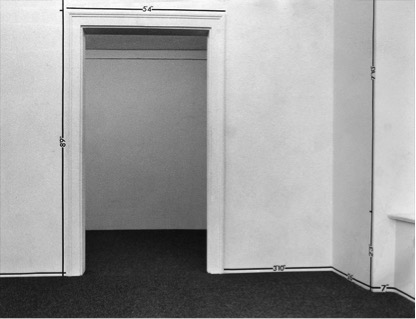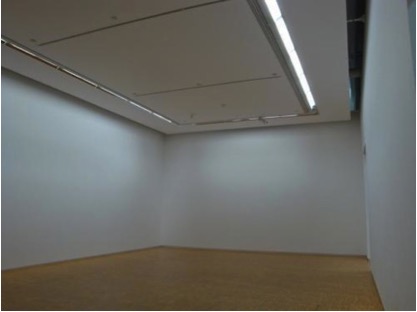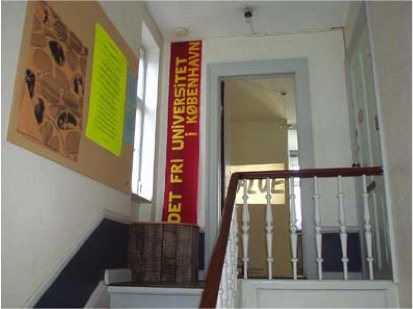Architectural elements of works of institutional critique often play a lesser role in the overall impression of the work, therefore the purpose of this essay is to identify how architecture and the uncanny have been used for institutional critique and what effect does psychologically to the viewer. This essay will attempt to answer the question by dividing the topic into 2 sub-questions: What is the Architectural Uncanny? And how has the Architectural Uncanny been used for Institutional Critique?
What is the Architectural Uncanny?
‘The “Uncanny” is that class of terrifying which leads back to something long known to us, once familiar’ (Freud, 1919, p1). The source of the term in relation to architecture is evident from its German equivalent unheimlich, which stems from the word heimlich meaning “homely” or “secret”. Therefore, somewhere that could be considered uncanny appears to be simultaneously familiar and foreign to us, a doubling of feeling that often leads to discomfort.
Freud notes that the uncanny often involves a fear of ‘a secret intention of harming someone’ emanating from the uncanny article. It is the projection of the viewer to create this secret, splitting the usually self-observed and censored ego forming a “double”, and the fear of the consequences should it be made un-secret – unheimlich – that would create such an aura of the uncanny within a place. It is this “double”, ‘a creation dating back to a very early mental stage, long since left behind’, that when it is ‘revived by some impression’ causes the feeling of the uncanny (Freud, 1919).
To understand how art or architecture can cause such an impression to revive this animistic feeling one must understand that they themselves are a doubling of nature. A work of art is the expression of an idea or intent. As such it may act to mimic the look of a landscape or simply convey a thought, however it will always act to replicate some facet of nature. Art can therefore be seen to be ‘uncanny because it veils reality, and also because it tricks. But it does not trick because of what is in itself; rather it possesses the power to deceive because of the projected desire of the observer’ (Vidler, 1992).
When it comes to architecture specifically, certain aspects indeed can contribute largely to the feeling of the uncanny.
‘Concerning the factors of silence, solitude and darkness, we can only say that they are actually elements in the production of that infantile morbid anxiety from which the majority of human beings have never become quite free’ (Freud, 1919)
Certainly the factors of silence, solitude and darkness share a common theme, they are all circumstances in which the ego is left to fill in a “blank” where there might else be sensory stimulation occurring. This could explain for the rise of the “double” in such circumstances and therefore the feeling of the uncanny. However, not all silent, lonely and dark environments do provoke the feeling and nor are they the only environments in which one might experience the unheimlich. The instrument of transformation is ‘when a symbol takes over the full functions and significance of the thing it symbolizes’ (Freud, 1919); such as when standing in an empty house and hearing sounds of life. The house symbolizes the people who live there, when it is empty and noise from the surrounding area is similar enough to e.g. the sound of footsteps above, the “double” projects forth these noises to be within the house, which has now taken the functions and significance of the thing it symbolizes. It is this, conjoined with the projected secret intention of harm that provokes the sensation of the uncanny.
How has the Architectural Uncanny been used for Institutional Critique?
Institutional critique is a practice of ‘confronting the institution of art with the claim that it was not sufficiently committed to… the pursuit of publicness that had brought it into being’ (Alberro, 2011) which came about in the 1960s and 70s and has continued as a field of artistic interest ever since.
For us to understand how it has been critiqued, we must first define what is meant by the ‘institution’. The first public art museum was The Louvre, born out of the age of enlightenment; its purpose was to educate the masses in these artistic theories and display national masterpieces. In doing so, the museum created a national past, ‘retroactively also [creating] the origin and foundation of the nation’ (Steyerl, 2006). Therefore, the ‘institution’ is deigned to be a blanket term to describe organizations that have control over the display and education of cultural practice as their doing so informs our view of a national identity.
The history of institutional critique has been identified as being divided into 4 waves of critique, each wave highlighting a different aspect of the institution that requires attention. These aspects are: Crisis, Collaboration (between Artist and Institution), Play and Pseudo Institution (Hjelde, 2015). I have identified an artist and artwork for each wave to investigate how each has used the uncanny in relation to architecture as a method for critique.
Before an investigation of the waves of critique, I think that it is important to look first at the work “1200 Coal Bags” by Marcel Duchamp. Shown in a Surrealist Exhibition in 1938, “1200 Coal Bags” consisted of what appeared to be 1200 cloth bags full of coal (in reality paper), hanging from the ceiling, leaking coal dust onto the floor below where a brazier stood, apparently lit. This piece at first challenged the idea of a gallery by using the space nobody else wanted: the ceiling. Secondly, with the brazier on the floor and the coal bags above, the whole space was turned on it’s head, the floor was above and the viewer was in fact walking on the room’s ceiling. The constant threat of a falling bag very literally weighed heavy over the viewer, the uncanny effect of this (the safe, familiar space that might mean harm) upsets the view of the power dynamic between the artist and institution in the eye of the viewer. They have no longer come to a gallery to view art but are viewing a gallery within an artwork that does not sit docile on a wall but seems to have its own intentions and desires.
‘This inversion is the first time an artist subsumed an entire gallery in a single gesture’. (O’Doherty, 1986)

With this piece, Duchamp paved the way for a series of artists to use the physicality of the building around a work as an integral factor of it. In turn there can be no analysis of the work itself without a reflection on the environment and therefore institution it is being held in.
The first wave of critique questioned ‘the authoritarian role of cultural institutions’ (Steyerl, 2006) asking ‘why shouldn’t the cultural institution be at least as representative as parliamentary democracy?’ Institutions were seen as a public space and state-funded; therefore they should represent the public that pays taxes to the state. This underrepresentation of the people is the “crisis” referred to and was dealt with by artists through a radical negation of the institutions all together. Alternate methods of distribution were called upon, guerrilla exhibitions held outside the traditional gallery space showed a subversive art that appropriated, and plagiarized, and sought to de-commodify their work leading to conceptualism (Critical Art Ensemble, 1996).

One such artist at the forefront of the conceptual art movement was Marcel Broodthaers. His work “Musée d’Art Moderne, Département des Aigles, Section XIXème Siècle” was first shown at his private house/studio in Brussels in 1968. This, as an example of such radical negation, forewent a traditional gallery space all together, undermining the expectations of a private home by holding within it a professional discourse. Although there may be no secret intention of harm, Broodthaers has intentionally made his home un-homely and it is this that takes precedence: the removal from a place of its expected character that causes the projection of the “double” and, along with the other factors mentioned earlier, the feeling of the uncanny. Vidler notes that in the modern city, thresholds no longer exist ‘save between waking and dreaming’, that ‘suburb, strip and urban centre have merged indistinguishably… we wander… surprised but not shocked by the continuous repetition of the same’ (Vidler, 1996) and it is here that Broodthaers enforces the uncanny. When crossing the threshold, one is shocked by the museum that occupies the space. This feeling would also be mirrored by the content of the work, where the viewer would be familiar with the practices of museums yet find themselves in an alien format of exhibition where on display was a heterogeneous collection of items rather than the homogenous collection traditionally found in a museum.

As the new avant-garde sought to undermine the institution, it became within itself more desirable because of its success in doing so. This led to the collaboration between the cultural institutions and the artists, leading to work that pointed out often disregarded aspects of such places. Mel Bochner’s “Measurement Room” (1969) was one such piece that focused more on an overlooked aspect of the gallery, that being the space itself as defined by its walls. Bochner measured the distances between features of a gallery such as doorway height, pointing out to the viewer the importance of the space itself and its creation in relation to their own bodies, instilling very consciously in the viewer’s mind a separation between them and the institution. These measurements serve to mathematize the gallery itself, reducing it to a set of variables, and in doing so they become the gallery that they symbolize. By using the uncanny in this way, as with Duchamp, the work has subsumed the gallery space and when the artist was asked to install it elsewhere, it was not one piece moving from one gallery to the next, but the gallery itself, as being a packet of information that was travelling from one location to another. Providing an open narrative able to leave comment wherever it is placed, maintaining relevance.

The idea of institutions as a public sphere was soon challenged, the bourgeoisie decided the cultural institution was also an economic one and as such should be subject to the laws of the market. Critics from the 1st and 2nd wave had now been absorbed into the institutions (Steyerl, 2006). Play was the necessary next step as in the 30 years since the start of the conceptual art movement, there is an ‘impossibility of any radically original gesture’ (Perret, 2002). Maria Echhorn’s work “Money at Kunsthalle Bern” (2001) was such an example of work that took a playful tone. She spent the commission money given on renovating the Kunsthalle itself, fixing many of the problems that had befallen it due to lack of funding.
Inside, builders could be seen busy at work, fixing the plumbing and repairing a windowsill. Walking around the empty gallery resulted in a feeling that something undefined was about to happen. (Perret, 2002)
Here Eichhorn has mirrored what Broodthaers did earlier. She has removed the pre-defined art from the gallery in place of an expression of the gallery itself, which was then marked down in meticulous detail, all the changes, in the catalogue.
Finally, the fourth wave of pseudo Institution or imitation; stemming from the earlier tactics of subversion, the pseudo institutions act not as pop-up galleries or workshops but as their own, independently formed, more ideology driven cultural centres. The Copenhagen Free University was one such organisation; founded in 2001 in a flat it acted as ‘an artist run institution dedicated to the production of critical consciousness and poetic language’ (Copenhagenfreeuniversity.dk, 2016). The CFU uses the uncanny in a very similar way to Broodthaers, breaking down the boundary between home and institution, unsettling a visitor with a violated sense of home.

The main theme that runs through all the examples given is an undermining of the viewer’s expectations of a space. I feel inclined to justify why the artworks still invoke the aura of uncanniness without instilling what might be as extreme as ‘terror’. Freud’s descriptions of the uncanny leave open the possibility of it being the mere unexplained unsettlement with regards to an environment. When put into an artistic context it matches well with the upsetting of expectations in such a way as to make aware to the viewer where they are, what they are doing and what relationship they have with the place they are in. This is the architectural uncanny and raises to the viewer their own investigations of the institutions they find themselves in. As a tool for critique it is an effective one, especially when it arises in the creation of home-held exhibitions and institutions, where the “double” exists not just in the ego but also in the world itself. However, there is great depth in its effects, and how it interacts with institution and the audience, that needs to be explored in future.
Bibliography
Alberro, A. and Stimson, B. (ed.) (2009). Institutional Critique. Cambridge, Mass.: MIT Press.
Baudrillard, J. and Kendall, S. (2006). Utopia deferred. New York: Semiotext(e).
Copenhagenfreeuniversity.dk, (2016). Information. [online] Available at: http://www.copenhagenfreeuniversity.dk/infouk.html [Accessed 21 Jan. 2016].
Critical Art Ensemble (1996). Tactical Media. in Alberro, A. and Stimson, B. (ed.) (2009). Institutional Critique, pp486-492. Cambridge, Mass.: MIT Press.
Feireiss, L. and Klanten, R. (2014). Imagine architecture. Berlin: Gestalten Verlag.
Foucault, M. (1971). The order of things. New York: Pantheon Books.
Harrison, C. and Wood, P. (2003). Art in theory, 1900-2000. Malden, MA: Blackwell Pub.
Hjelde, K. (2015) Institutional Critique [Lecture to BA Fine Art Year 2], Unit 7: Theoretical Contexts 1. Chelsea College of Arts. 23 November.
Kyong won, S. and Angelidakis, A. (2008). Internet suburbia. Seoul, Korea: DAMDI.
lucarelli, f. (2014). Mel Bochner’s Measurements (1968-69) – – SOCKS. [online] SOCKS. Available at: http://socks-studio.com/2014/10/08/mel-bochners-measurements-1968-69/ [Accessed 23 Jan. 2016].
McShine, K. (1999). The museum as muse. New York: Museum of Modern Art.
Moussemagazine.it, (2016). Marcel Broodthaers, “Musée d’Art Moderne, Département des Aigles, Section des Figures,” 1972 – THE ARTIST AS CURATOR #5 / MOUSSE CONTEMPORARY ART MAGAZINE. [online] Available at: http://moussemagazine.it/taac5-a/ [Accessed 23 Jan. 2016].
Noshowmuseum.com, (2016). NO SHOW MUSEUM. [online] Available at: http://www.noshowmuseum.com/en/1st-a/maria-eichhorn [Accessed 23 Jan. 2016].
Perret, M. (2016). Frieze Magazine | Archive | Archive | Maria Eichhorn. [online] Frieze.com. Available at: http://www.frieze.com/issue/review/maria_eichhorn/ [Accessed 21 Jan. 2016].
Schaffner, I., Winzen, M., Batchen, G. and Gassner, H. (1998). Deep storage. Munich: Prestel.
Steyerl, H. (2006). The Institution of Critique. in Alberro, A. and Stimson, B. (ed.) (2009). Institutional Critique, pp486-492. Cambridge, Mass.: MIT Press.
Toutfait.com, (2016). Marcel Duchamp. [online] Available at: http://www.toutfait.com/issues/volume2/issue_4/interviews/hirschhorn/popup_8.html [Accessed 25 Jan. 2016].
Vidler, A. (1992). The architectural uncanny. Cambridge, Mass.: MIT Press.
Categories: Research

I often visit your blog and have noticed that you don’t update it often. More frequent updates will give your site higher authority & rank in google.
I know that writing articles takes a lot of time, but you can always help yourself with miftolo’s tools which will shorten the time
of creating an article to a few seconds.
I see you don’t monetize your blog, don’t waste your traffic,
you can earn extra cash every month. You can use the best adsense alternative for any type of
website (they approve all websites), for more info simply search in gooogle: boorfe’s tips monetize your website